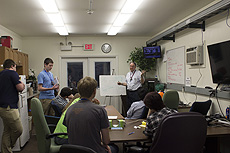High school students are 'beaming' at the Fermilab Test Beam Facility
 |
The team of students from Glenbrook North High School attends a morning colloquium with teacher Nate Unterman before working at the Fermilab Test Beam Facility. Photo: Ashley Black, OC |
It isn't your typical science fair fare: Students from Glenbrook North High School in Illinois have carried out an experiment in a way that very few high schoolers will ever get to do — using a high-energy proton beam at America's premier particle physics laboratory.
The group recently spent a week at the Fermilab Test Beam Facility to help investigate a potentially better method for testing nuclear reactor cladding materials.
"We're really excited about this," said 18-year-old Julia Masterman. "Our main goal is to try to make nuclear reactors better in the long run."
Many nuclear reactors and their materials have not been updated in 20 to 30-plus years. Nuclear cladding material is currently tested for durability by putting it in a nuclear reactor, waiting two or three years and then pulling it back out. By analyzing the crystalline structure, researchers can determine characteristics such as brittleness. That's an expensive, time-consuming task that requires a rather large sample, explained 16-year-old Brian Burke.
"In order to have a new generation of nuclear reactors, to make them better, safer and more efficient, you're going to need new materials," Masterman said.
Using a high-energy proton beam could prove to be cheaper and more efficient than current methods, and Glenbrook North's experiment checks whether this method can be used as an alternative to a test reactor for material that would usually go into a nuclear reactor.
Neutrons and protons have virtually the same size and weight, and this makes proton accelerators prime candidates for re-creating the bombardment and energy transfers found in nuclear reactor environments. If successful, the protons will mimic the effect of neutron bombardment that the cladding material experiences in a nuclear reactor.
"We want to be able to expedite the testing process and make it better and less expensive, and we also really love the science that's involved," said 17-year-old Yaal Dryer.
To formulate their experiment idea, the students traveled around Illinois to attend lectures and talk with experts. After trips to Fermilab, Argonne and Northwestern University, they hypothesized their solution. Then, once the students had gone through safety training and Fermilab personnel had surveyed the test area for radiation, the high school team got to work.
"We've already learned a lot of just how science works in the real world," Masterman said. "You can't really understand particle physics without being out here and seeing the scale of everything."
The group's mentor and teacher at Glenbrook North High School, Nathan Unterman, approved of his students' curiosity.
"They know way more than I do; they are more expert on this than I am," he said. "That's how I like it — I want to be a teacher that gets the students to exceed my capabilities."
The Fermilab Test Beam Facility accepts proposals from researchers around the world who want to test their detectors and technologies. Hopefully even more high school students can have similar experiences, working with the same advanced technologies that professional scientists use.
"Each week there's something new, and it's very interesting to see the different groups and their dynamics," said Fermilab Test Beam Facility Manager Mandy Rominsky. "It would be nice to keep doing similar outreach for younger people."
—Ashley Black
|